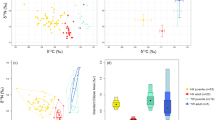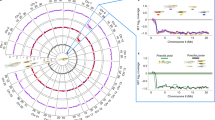Summary
The estuarine isopod Sphaeroma rugicauda is polymorphic for body colour. The frequency of one morph, Yellow, was studied over a 3-year period in a population in the Tyne estuary, East Lothian, Scotland. The Yellow form is controlled by a single dominant gene, the recessive condition being represented by the morph Grey, which is at a frequency of around 0·60 in the population studied.
An initial inspection of the frequency data suggested that Yellow declined in frequency over the October-January period and increased in frequency over the January-March period. These two periods were characterised by water temperatures estimated to be 12°-5° C. and below 5° C. respectively, and salinities were generally low over both periods.
Experimental comparisons of the survival of Yellow and Non-Yellow showed that at 10° C. and low salinity, Non-Yellow survived better and that at 0° C. and low salinity, Yellow survived better than Non-Yellow.
The frequency data were then re-analysed, after dividing them up on the basis of the experimental temperatures. In 2 years Yellow showed a significant decline in frequency over the October-January period. In only 1 year, characterised by exceptional mildness did Yellow increase in frequency over the January-March period. In the other 2 years, Yellow did not increase in frequency over this period but did seem to increase in frequency once the temperatures rose above 5° C. A possible explanation of this reversal in survival is put forward, based on differences in growth rate between the two morphs.
Natural selection provides the most likely explanation for the observed frequency changes. It seems probable that the two morphs are maintained in the population by the action of these two or more opposing selective forces, alternately favouring the Non-Yellow and Yellow morphs.
Similar content being viewed by others
Article PDF
References
Bishop, J A. 1969. Changes in the genetic constitution of a population of Sphaeroma rugicauda (Crustacea: Isopoda). Evolution, 23, 589–601.
Cook, L M. 1971. Coefficients of Natural Selection. Hutchinson & Co., Ltd., London.
Dobzhansky, T H. 1947. Genetics of natural populations, XIV. Genetics, 35, 288–302.
Heath, D J. 1973. Ecological factors affecting gene frequency in a polymorphic isopod, Sphaeroma rugicauda (Leach). Ph.D. thesis, University of Edinburgh.
Newberry, K. 1971. A further study of four morphs of Sphaeroma rugicauda (Crustacea: Isopoda). Unpubl. M.Sc. thesis, University of Liverpool.
Snedecor, G W, and Cochran, W G. 1971. Statistical Methods. The Iowa State University Press.
Strickberger, M W, and Wills, C J. 1966. Monthly frequency changes of Drosophila pseudoobscura third chromosome gene arrangements in a California locality. Evolution, 20, 592–602.
West, D A. 1964. Polymorphism in the isopod Sphaeroma rugicauda. Evolution, 18, 671–684.
Author information
Authors and Affiliations
Rights and permissions
About this article
Cite this article
Heath, D. Seasonal changes in frequency of the “Yellow” morph of the isopod, Sphaeroma rugicauda. Heredity 32, 299–307 (1974). https://doi.org/10.1038/hdy.1974.39
Received:
Issue date:
DOI: https://doi.org/10.1038/hdy.1974.39
This article is cited by
-
A comprehensive test for negative frequency‐dependent selection
Population Ecology (2013)
-
Genetic variability and environmental variability in the estuarine isopod Sphaeroma rugicauda
Heredity (1985)
-
Dynamics of an enzyme polymorphism in the isopod, Sphaeroma rugicauda (Leach). I. Temporal variation in genotype frequencies
Heredity (1983)
-
Colour polymorphism, selection and the sex ratio in the isopod Sphaeroma rugicauda (Leach)
Heredity (1979)
-
Colour polymorphism in the salt-marsh isopod, Sphaeroma rugicauda; Evidence for stable equilibrium frequencies
Oecologia (1979)



